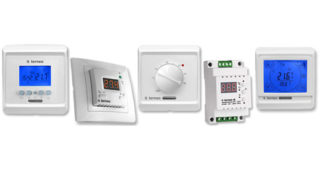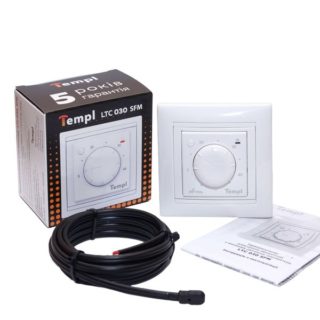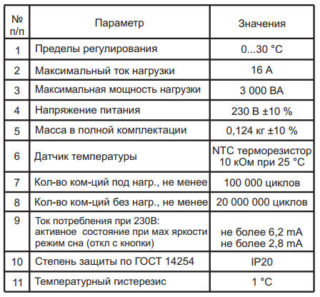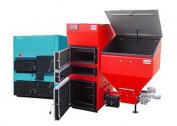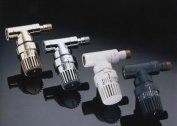The desired mode of the heater is set using the thermostat for the heater. The appliance starts and turns off automatically when the desired degree of heating is reached. The practicality of the device and the features of work depend on the type of analyzing sensor that determines the temperature of the surrounding space. Cold activates the bimetallic plate, and the circuit closes, and when the desired temperature is obtained, the relay turns off the electricity supply.
The main types of temperature controllers for the heater
Outlet and sub-outlet regulators for electric heater are available. The first type does not require special skills and simply plugs into a power outlet, where the heater cord is then connected.
According to the principle of operation, the thermal relays for the heater are distinguished:
- electronic;
- electromechanical;
- thermostats.
There is a built-in or remote device that collects information about the temperature in the surrounding area. The device is placed in the wall of the room outside the location of the heater.
Electronic
The circuit includes an output relay, a sensor, a panel with touch or overlay control keys, a rotary controller. The models have a microprocessor for processing commands and signaling to action, a thermometer. Electronic devices are equipped with a monitor to display user information. The supply voltage is 24 V.
GSM controlled models accept commands from any area of the city with mobile communications. A separate SIM card is inserted into the slot on the control device. The device regulates the room temperature in the range from 0 to + 40 ° C.
Electromechanical
The design of simple devices includes a bimetallic plate that coordinates periodic shutdown and start of the device. Adjustment and adjustment of parameters is carried out by a rotary toggle switch or lever.
Depending on the installation method, they distinguish:
- stationary models that are built into the wall and connected to the power supply cable;
- the temperature controller in the outlet for domestic heaters is transferred and used in any room.
There are models with remote and built-in sensor for receiving information. The first option is located on the end of the wire connected to the regulator. Cable length varies from 0.1 to 3 m.
Thermostats
The controller operates with a temperature in the range from 0 to + 35 °. The value is set by a round toggle switch surrounded by a numerical scale. The device adjusts to the power of the connected load so that the temperature readings are read correctly. LEDs inform about the operating mode and report problems with the temperature sensor.
The thermostat for the heater saves electricity by controlling the degree of heating. Strong heat of the heat source leads to the burning of oxygen and a decrease in humidity in the room to critical limits.
Thermostats for infrared heaters
The devices are characterized by two sensors in the design, one of which controls the heating of the heat source, and the other monitors the temperature in the room. At the same time, the work of the infrared heat exchanger and the microclimate are coordinated.
Mechanical
Devices are easily configured and installed. A mechanical thermal switch for a heater is cheaper than electronic options, the measurement error is 2 ° C.The disadvantages include the ability to set one temperature value without a range.
The device is a small plastic box with a switch on the outside. The round toggle switch moves smoothly, with its help the value on the scale is selected. The divisions are spaced at 1 ° C or there is a transition length of 3 ° C. The case is equipped with a shutdown button and indicator lights to control operation. There are mechanical thermostats for an electric heater with a screen where some numbers are displayed.
Programmable
Devices create maximum comfort in controlling the heat exchanger. The temperature range is +5 - + 45 ° C, which expands the scope. They differ from mechanical ones in that they take into operation a complex program for heating the premises for several days and weeks in advance.
The accuracy of temperature measurement is 0.5 ° C. When choosing, you need to take into account the non-volatility of the device memory so as not to set values many times after a power outage. The latest plant models are available with liquid crystal displays.
Devices are effective when people leave home. They are controlled by touch or overlay keys, depending on the model.
Specifications
Work parameters depend on the version, filling and control scheme. Some temperature regulators for quartz heaters or oil heaters are connected 2 - 3 remote sensors. The built-in GSM-modem provides voice notification and electronic newsletter about the microclimate status to the specified telephone numbers with the indication of operation parameters.
Features of modern temperature controllers:
- connection to eight telephone numbers and regulation of 4 alarm zones in the home;
- coordination of parameters and task setting by means of mobile communication or voice message;
- sending SMS messages when the power is turned off, the battery is low;
- models withstand power 2 - 3.5 kW.
When connected, the consumed current of the heaters is summed up, this value should be less than the maximum value for the thermostat.
Advantages and disadvantages
The device saves electricity, because with the right task, the heaters function no more than 5-8 hours a day.
Advantages of thermostats:
- optimization and uniform settings of individual heaters, convectors and the entire heating system;
- maintaining the minimum necessary temperature in the absence of a person in the house;
- redistribution of the heating power of heating devices in the entire apartment or office, while the inclusion can be specified in a cascade that excludes overloading the mains.
The disadvantage is that it is not recommended to install thermal switches in bathrooms due to high humidity and steam, and also to place them near heaters, cold sources, in a draft in the basement or in the sun.
Basic rules for choosing
When buying, pay attention to the scope of control of the device. There are temperature sensors that regulate only the heating of the heater itself, and not the microclimate in the room. The purpose of the room is taken into account, since for the bedroom and kitchen the temperature parameters may differ, and it should be possible to set parameters for any zone.
The cost of models depends on the number of additional functions, so a device is bought in which you do not need to overpay for extra features. The shape and color of the thermostat is important so that it fits the interior.
Scope of application
Devices are used to regulate heating in residential and industrial premises. In office buildings, a temperature range is set at night that maintains minimal heating until the morning when people arrive.
In private homes, controller functions vary by model. There are outlet devices that simply turn the air heater on and off, but complex options are installed for the complex coordination of all equipment. For example, such temperature controllers are included in the control system "Warm House".
